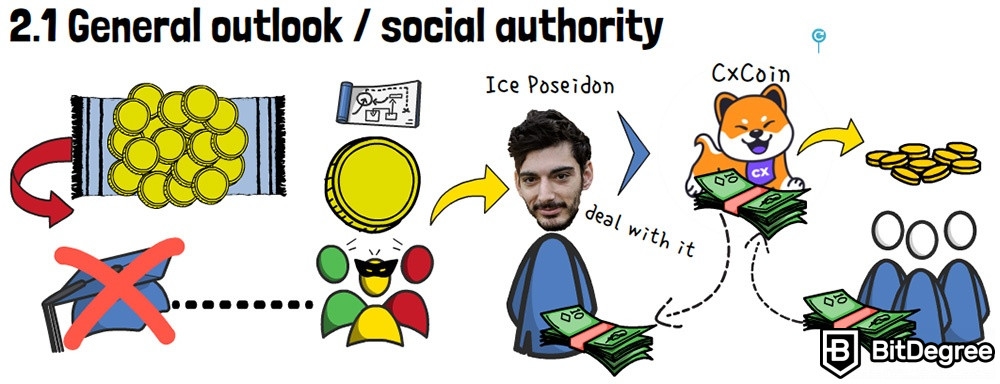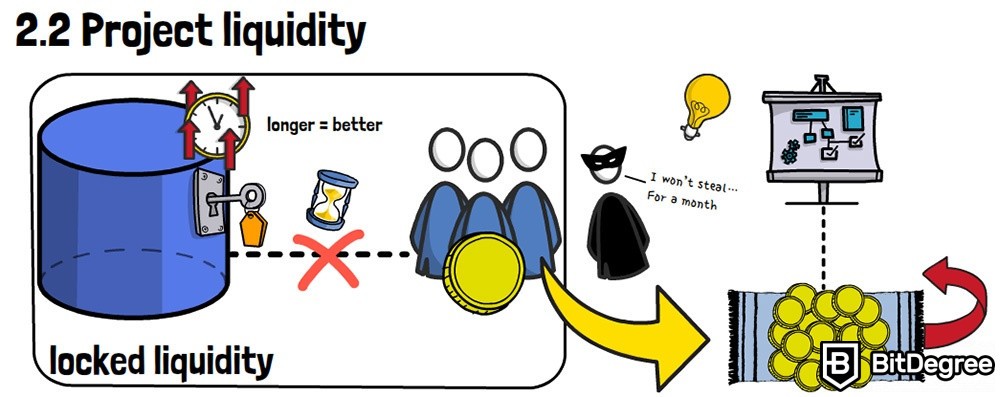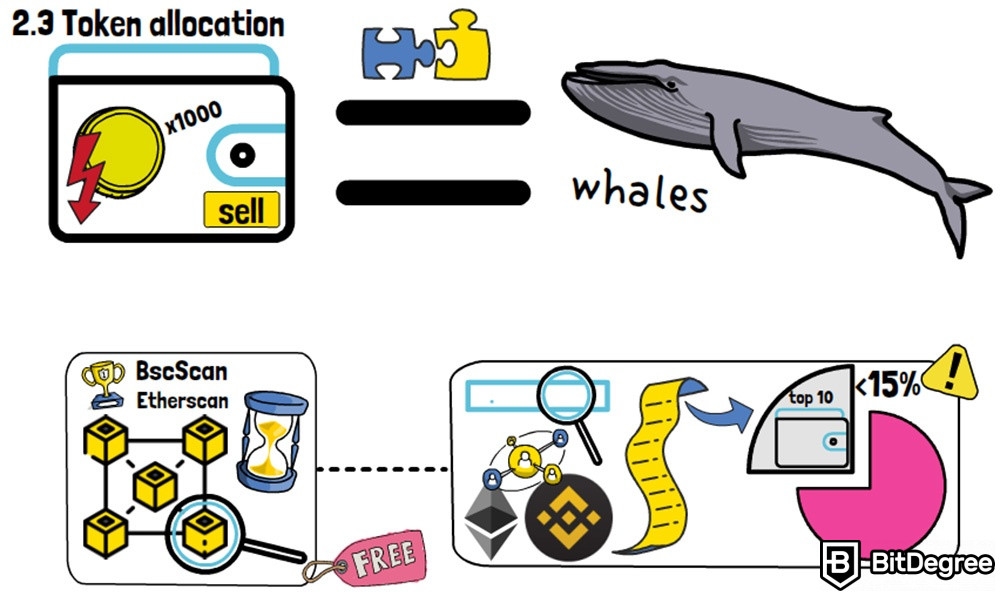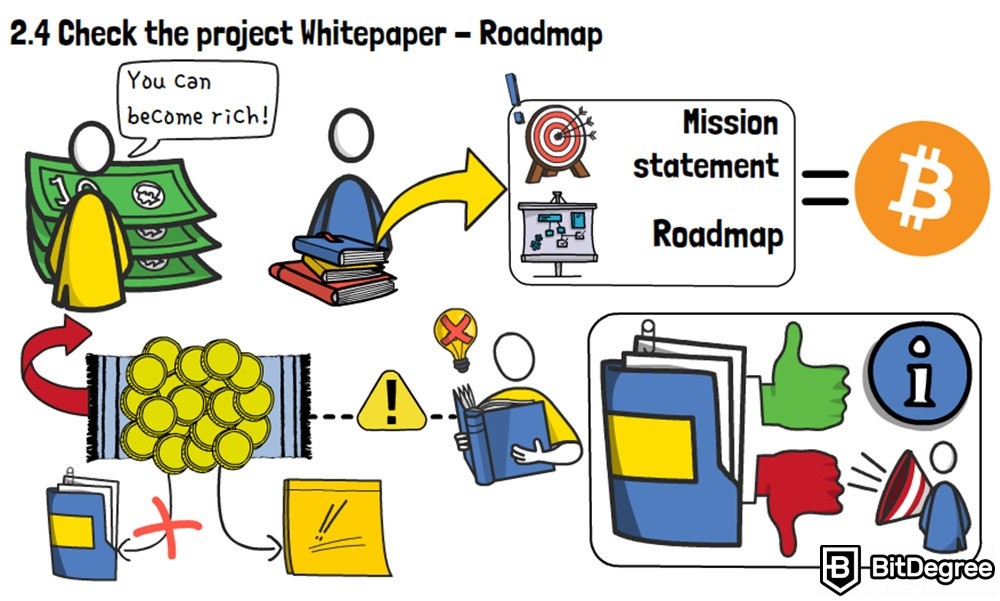7.11 How to Spot and Avoid Rug Pulls?
Free Airdrop Season 7 is LIVE! Answer fun questions or do simple tasks to earn rewards from the $30K BitDegree prize pool. Participate Now ! 🔥
In this section, I’m going to tell you how to avoid rug pulls in crypto!
Have you or your friends ever been “rug-pulled”? Have you ever come across an enticing crypto project that offered otherworldly returns, only to eventually find out that it was a scam all along?
As cryptocurrencies become more and more popular, there’s an ever-increasing number of rug pulls happening, as well. This is why it’s super-important to be able to spot a potential rug pull before it happens, so that you wouldn’t lose out on your entire investment!
In this section, we’re going to cover rug pulls. Specifically, I’ll tell you how you can spot a potential rug pull, and what measures you can take to avoid it!
Let’s get to it!

Video Explainer
Video Explainer: How to Spot and Avoid Rug Pulls?
Reading is not your thing? Watch the "How to Spot and Avoid Rug Pulls?" video explainer
How to Avoid Rug Pulls in Crypto? (5 Ways Explained)


What is a Rug Pull?
If you’re new to rug pulls, in general, and haven’t got the slightest clue of what they are, you should stop everything you’re doing now, and go read the section dedicated to rug pulls. I won’t go in-depth on what a rug pull is here, since this section is meant to serve as a continuation to that other one I’ve just mentioned.
To keep it short, a rug pull is a type of a crypto scam. Rug pulls happen when project developers or owners run away with the investors’ funds - in other words, investors get “the rug swept out from under their feet”. That’s where the term came from!

As I’ve already told you above, with crypto becoming more and more popular, there’s a surge in rug-pulling activities, as well. Never before has it been so crucial to learn to protect yourself from the various scams floating around the internet!
This is even more so true when you consider the fact that there are multiple different rug pulling techniques that these scammers employ. Don’t worry, though - no matter how many different ways they might come up with scamming investors, the methods of how to spot and avoid a potential rug pull always remain the same.
How to Spot and Avoid a Potential Rug Pull?
Continuing on with the section, let’s take a look at 5 of the most common signs that a project could be a potential rug pull in the making. If you notice any of these signs, you should be cautious - if you notice all of them, well… I don’t think I even need to say it out loud!
Do keep in mind that just as these signs could signal a potential crypto project rug pull in the making, the same is true for NFT projects, as well. Many of these same signs should be examined and looked into, when you’re trying to find out how to avoid an NFT rug pull.
General Outlook / Social Authority
So, for starters, when you’re looking into a crypto project, you should first examine the project from afar. What I mean by that is how do they do their marketing? Is there a legitimate community that believes in the project and its purpose? Or are mainstream celebrities and high-profile YouTubers talking about it?
Most legitimate projects aren’t going to do sponsored videos from YouTubers, or social media posts from celebrities. That’s because they know that a) it looks fishy, and b) neither those celebrities, nor the YouTubers likely know anything about crypto, or at least the project that they would be promoting.
As you can imagine, in this scenario, the whole entire ordeal would come off as rather disingenuous! Solid and well-designed projects don’t tend to go out of their way, and search for non-related, high-profile names to promote them. Instead, all of the marketing is done by the actual company or team behind the project, and the community that they’ve managed to attract.
So, in short, the very first sign that a project might be a potential rug pull is if you notice that there are suddenly a lot of high-profile people, who would otherwise have nothing to do with crypto, talking about a specific new coin or token.
I have to say, though, this can get tricky, since sometimes, the actual influencer is the bad guy. If you want an example of what an alleged rug pull looks like, one of the most recent high-profile cases would be that of the streamer Ice Poseidon, and the CxCoin.

Paul Denino - better known online as Ice Poseidon - had created and advertised a platform for content creators, where they could get paid in cryptocurrencies. Then, after investments started flocking in, he took almost all of the money out of the project, and appears to be quite shameless about it!
This just goes to show that even online stars themselves can allegedly rug their fans. Thus, you should be very cautious!
Liquidity
The second sign that you should look out for, if you want to avoid rug pulls, has to do with project liquidity. It’s a whole huge topic, but what you need to know for now is that a project’s liquidity can definitely tell you a lot, in terms of a potential rug pull!
If you check out the liquidity of some sort of a new project (or, token), and see that it’s very low, that’s already a red flag. Projects that have liquidity up to around $100k are often seen as being very easy to manipulate! Think about it yourself - if there are only a few thousand dollars worth of tokens in the liquidity pool, the project owners could simply deposit $1000 into the pool, which would artificially increase the price of the token significantly!
Put simply, if a project has low liquidity, it means two things - that the team behind the project hasn’t invested a lot of their own money into it, and that the price of the token behind the project is very easy to manipulate.
This actually leads us to the second part of this liquidity-related sign of how to spot a rug pull - locked liquidity.
What this term essentially means is that the team behind a token has locked the liquidity of their project, for a specific period of time, and they won’t be able to access it. This is a good thing!

If developers or project owners lock liquidity, there's a much smaller chance that they’ll rug pull the project, since it becomes much more difficult to do. Of course, there are still ways how scammers are able to do their scamming, but it’s still a point of reassurance!
Note, however, that the liquidity should be locked for a longer period of time. If it’s locked for a month or even a year, well… That’s nothing, really! It’s as if a thief would come to you, and say - hey, don’t worry, I won’t steal your money… For a month. After that, well - we’ll see.
Of course, do keep in mind that not all situations are the same - unlocked liquidity isn’t an immediate sign that a project is a rug pull, since there are many variables to consider, and many different projects with different goals and mechanics. That being said, if you see that a project hasn’t got locked liquidity, you should be very careful!
By the way, if you’d like to learn more about liquidity - what that is, how it works, and so on -, you can check out the dedicated section on the topic - here!
Token Allocation
The third major thing to look into is token allocation. In other words, you need to check out how many tokens are held in a few of the top wallets (also known as whales).
Thankfully, that’s super-simple to do! There are special services called blockchain explorers. The two most popular ones are Etherscan and BscScan - on them, you can enter the smart contract address of any project built on the Ethereum or Binance Smart Chain networks, respectively, and check a list of wallets holding the most project tokens.

If you see that the top 10 wallets hold over 15% or 20% of all of the available tokens, this is a tell-tale sign to stay away from that project! What could happen is the whale wallets could decide to dump all of their tokens into the market, thus crashing the price of the token in a matter of minutes.
Checking project token allocation is completely free to do, and typically takes only a few minutes. Make sure to do so with all projects that you are planning to invest in! After all, it’s one of the simplest ways of how to spot a rug pull.
Check the Project Whitepaper - Roadmap
Number four has to do with the Whitepaper of the project.
Imagine a friend came to you, and told you about “this amazing new company” that he invested money into, and he suggested you do the same. Well, before going out there and putting your money into that company, you would probably try to do some research on what it is that they do! Part of your research would surely include looking into the company’s mission statement, its roadmap, and so on.
Well, cryptocurrency projects are the same! If you want to avoid getting rugged, checking out the project’s Whitepaper or its roadmap is essential!
Many rug pulls in the making don’t have solid Whitepapers. Instead, they are filled with random crypto buzzwords, and are usually very short. If you read through the Whitepaper, and come out understanding less than you did before checking it out, that’s a clear sign to stay away from the project!

Whitepapers are also a great way to get to know what the project is all about. A good rule of thumb for you to follow is this - if the Whitepaper looks like a sales pitch, and appeals to your emotions (in other words, desperately tries to sell you something), it shouldn’t be taken seriously, at all.
“I’ve Seen This Before”
Now, the fifth and final method of how to avoid a crypto rug pull is something I like to call “I’ve seen this before…”. You should imagine me saying this with a really suspicious expression on my face.
So basically, it’s pretty simple - if you feel like you’ve seen this exact project model a few times already, you might be getting rugged. That’s because most scammers don’t bother with creating a new and enticing project - instead, they simply copy-paste the code from another project, and only change a few variables, such as the name of the token.
This is true both with the way that the project is presented, as well as the code behind it. If you know what you’re doing, and where to look, you could basically “create” (or copy) a “new” cryptocurrency project in a matter of hours, if not minutes.
That sounds very dangerous if you’re an investor. However, it’s also a good thing, since it makes picking and choosing the right crypto project for yourself much simpler!
If you feel like you’ve already read that Whitepaper a few times before, or have seen this exact same marketing gimmick, again and again, you should probably avoid investing in the project, since it might end up being a rug pull.
Conclusion
There are various other ways how you can spot and avoid rug pulls, but I’ve told you about five of the most common and notable methods. If you spot any of these within a project, or are simply feeling that something isn’t quite right, you should avoid investing your money into it - this will potentially save you from a huge headache in the long run!










